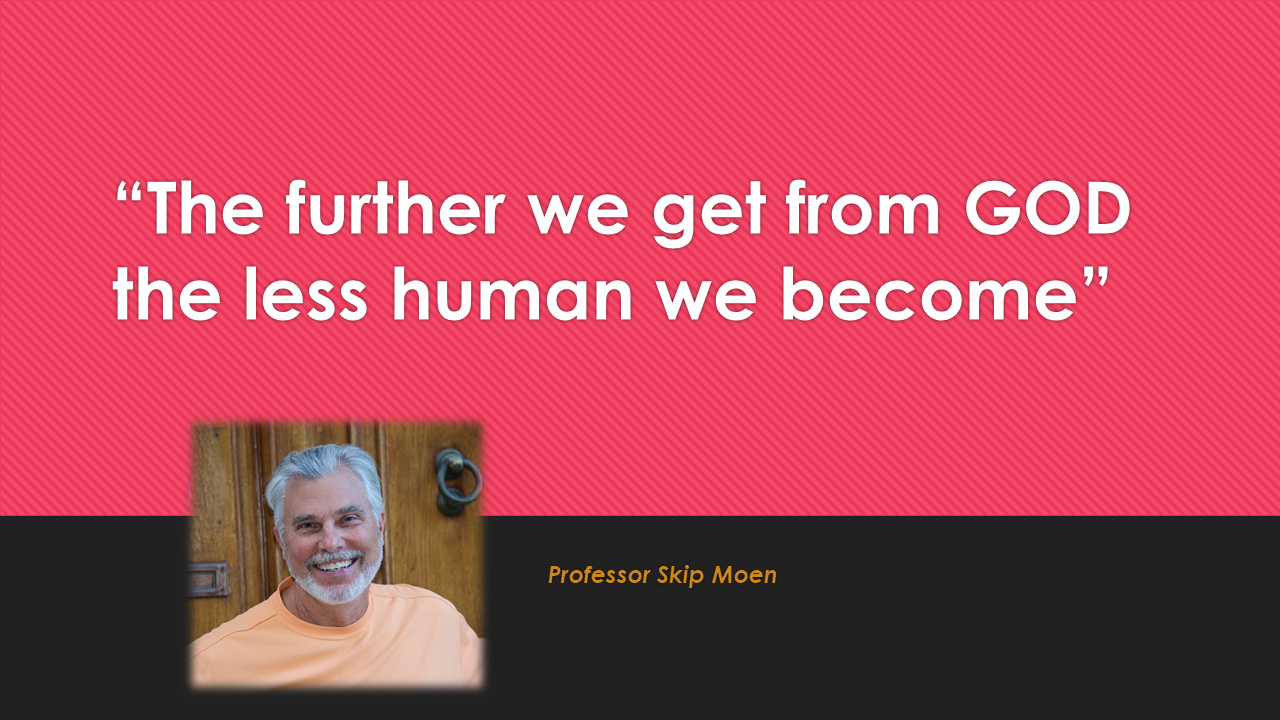I thought this to be a good read!
Early Christianity and Judaism
“One of my graduate students wrote this excellent review of the historical and theological issues in early Christianity. He has agreed to offer it to the community.”
(You might consider the following two lectures, “Formation of the Christian Church”)
A Paper by Rev. Peter Fast
Any discussion on Christianity’s relationship with Judaism will always present a complex picture of the two communities. Theological differences, historical happenings, Church persecution, and Christian de-Judaizing must all be accounted for and examined to understand where Christianity and Judaism now stand today. Within that framework of discussion, the modern church has had its own internal struggle on how it balances its overwhelmingly Gentile Christian number with that of a minority of Jewish believers who find themselves within the fold. For many Gentile Christians, the Jewishness of the New Testament and their own Hebraic roots as believers is far from their mind and inconsequential. Many pastors and seminary professors teach/assume that the Old Testament, although it contains many good applications for the modern Christian, is dead religion and legalistic, having been superseded by the Church. However, for Jewish believers this could not be further from the truth. Making up a small demographic within the body of Christ, most messianic Jews observe the feasts, keep Sabbath, maintain kosher dietary laws, and view themselves as part of the community of Israel, yet at the same time not viewing themselves as severed from Christianity. Naturally, these two expressions can stir up a host of emotions between Jewish believers and Gentile Christian believers. Surrounding ongoing doubt and contention, the challenge of the modern church is that it largely remains ignorant pertaining to issues of Judaism, Jewish life, and believers who are both Jewish and wish to continue to identify themselves as Jewish. This paper will examine the gap between Jewish believers and Christian believers and what must be done, on behalf of Christians, to heal that gap through practical steps and theological insight.
When shedding light on how the historical Church has viewed Judaism and its influence, Christianity has sought to distance itself. Sprouting from a Jewish root, the early believers in Jesus were predominantly Jewish, proud defenders of Torah, keepers of Jewish traditions, ceremonial customs, dietary laws, ritual observances, and upholders of circumcision. These Jews had come to believe that Jesus was the long awaited Messiah, yet they continued in the practices of their forefathers, as testified by Paul himself.[1] “While he followed his Savior in doing away with traditions that stood contrary to the written Torah, we do see in Paul’s letters recognition of the value of tradition and even the necessity of it within the community of faith.”[2]
Other Jewish believers came from more of a Hellenized way of life and were more liberal and open to change. However, both groupings of Jews were united in the belief that Jesus was the Anointed One and thus, the head of the ekklesia.[3] This testimony came from the lips of Jesus himself, then was passed down by the disciples and other believers, including Paul. Yet, this Jewish foundation was an essential part of the ekklesia makeup. It gave credence to Jesus’ own declaration that He had not come to abolish the law and the prophets[4] but to fulfill them. For the Jewish believers of the first century, Jesus as the Jewish Messiah only reinforced that they were a part of the faithful remnant of Israel, pictured as an olive tree in Paul’s letter to the believers in Rome,[5] and for Gentile believers that meant they were grafted in as part of the commonwealth of Israel.[6]
Yet as history commenced, Gentile believers began to view the Jews and Israel as having been replaced, by what they later called the Church.
In our day the word “church” is a technical term denoting a religion which has either replaced or is opposed to the Synagogue. When we read our English translations and find in them the word “church,” our natural inclination is to presume that the Apostles, and particularly Paul, were instrumental in beginning something that stands outside of the “congregation of Israel,” something with its own institutions, practices, beliefs, and rewards.[7]
This stands contrary to the evidence in Paul’s own Epistles on how he saw the relationship between Jewish and Gentile believers. Evidence of this relationship is shown particularly in the outcome of the Jerusalem Council of Acts regarding the four stipulations placed upon Gentile believers, Paul’s use of the word ‘ekklesia’ which holds Hebraic associations not part of our modern understanding or use of the word ‘church’, and Paul’s stern reminders of Israel’s place[8] all point towards an attempt by the apostle to keep the messianic fold a part of the Jewish community, without compromising on his defense regarding Gentile acceptance within the body of believers and issues of soteriology.
Paul did not want Gentiles to think they needed to become Jews nor that they even could become Jews. Neither did he want Jews to think that they needed to cease being Jews nor that they could. Paul expects both Jew and Gentile to keep the commandments. It seems very possible, then, that Paul would have had no problem with a Gentile remaining a Gentile, yet being circumcised. What he would never allow was a Gentile undergoing the Rabbinic ritual of a proselyte with the notion that such a ceremony would gain him the status of “righteous.” This was surely “another gospel” and to Paul anathema.[9]
Yet all of this gradually changed over time where most of the ‘church’ allegorically interpreted Scripture to cleanse itself of Jewish and Hebraic affiliations and identity within its own practices. One example of this was the question of Christians celebrating Passover as opposed to establishing the date of Easter, all of this being addressed during the Council of Nicea in A.D. 325 where Emperor Constantine concluded,
We would have nothing in common with that most hostile people, the Jews; for we have received from the Redeemer another way of honoring God, and harmoniously adopting this method, we would withdraw ourselves from the evil fellowship of the Jews. For what they pompously assert, is really utterly absurd: that we cannot keep this feast at all without their instruction…It is our duty to have nothing in common with the murderers of our Lord.[10]
This downward spiral which continued from Nicea, also affected the standing of believers who identified themselves as Jewish. In the minds of the church fathers, Jewishness equalled legalism and the enemy of the church. Therefore, for a Jew to believe in Jesus, they had to be cleansed of their ‘Jewishness’ in order to become ‘Christian.’ This is echoed in St. Jerome’s correspondence with St. Augustine of Hippo.
In our own day there exists a sect among the Jews throughout all the synagogues of the East, which is called the sect of the Minei, and is even now condemned by the Pharisees. The adherents to this sect are known commonly as Nazarenes; they believe in Christ the Son of God, born of the Virgin Mary; and they say that He who suffered under Pontius Pilate and rose again, is the same as the one in whom we believe. But while they desire to be both Jews and Christians, they are neither the one nor the other.[11]
In the paradigm of the church fathers, it was an impossibility to be both a Jew and a Christian. For to them, one represented the shackles of legalism and the other the liberty and freedom of grace. This is so obviously clear in the medieval statues depicting the Synagogue and Church. The woman representing Synagogue is blindfolded, looking downward in defeat, with her staff, a symbol of authority, broken. On the other hand, the woman representing Church holds a chalice, stares defiantly at Synagogue, is clothed in royalty, and is adorned with a crown.
In the case of Jewish believers, “Jerome denied them their claim of being Christian, because they claimed to be Jews; he denied them their claim to be Jews, because they claimed to be Christians. And he certainly denied them the possibility of being both, because that was an impossibility in Jerome’s worldview.”[12] In other words, the response was clear and to the point: “If, thunders Jerome, you believe in the Nicene Creed, get out of the synagogue, and you will be a Christian. If you stay in the synagogue and drop your belief in Christian doctrine, then the Pharisees[13] will agree to call you a Jew.”[14] This would be the continual standard in which the church would approach believers who either identified themselves as Jews or wished to observe what the church labeled as ‘Jewish practices.’ These people were summarily isolated, deemed heretics, and banned from the church which believed itself to be protecting its orthodoxy and purity by keeping out ‘Judaizers’.[15] For many people today and throughout history, the term ‘Judaizing’ was wrongfully understood to mean anyone who desired to maintain or return to the Hebraic roots of their faith. However, in a Biblical sense, this is just not the case. “Some Christians protest when any call is made for non-Jewish believers to return to the Jewish roots of early Christianity, for such a return seems like Judaizing, which Paul battled. In Bible times, Judaizers were gentile converts who followed the religious practices and customs of Judaism.”[16] These very same people went beyond Torah observance into pressuring others to follow these practices and customs for the justification of their salvation, which Paul no doubt opposed.
Ever since Nicea, the relationship between Jewish believers and Gentile Christian believers has been one of suspicion, hurt, division, and misunderstanding. To heal this wound and overcome this stigma, Christian believers must confront history and the Biblical understanding of the New Testament world as well as return to the Jewish ideology and identity of Paul, the disciples, and Jesus himself. This calls for revision within the church. For centuries the church has framed the debate between Judaism and Christianity, by approaching it from the angle that Jesus as a Christian pastor confronting the synagogue. For many Christians, Paul was a man who broke from Judaism, thus creating the new religion of Christianity whereas Jesus was its founder. Speaking of Paul’s Damascus road experience, in his exhaustive record of Church History, Philip Schaff states, “This revelation was enough for an orthodox Jew waiting for the hope of Israel to make him a Christian, and enough for a Jew of such force of character to make him an earnest and determined Christian.”[17] Schaff also goes on to call Jesus the founder of Christianity and stereotypes the Pharisees by stating,
They represented the traditional orthodoxy and stiff formalism, the legal self-righteousness and the fanatical bigotry of Judaism…They confounded piety with theoretical orthodoxy. They overloaded the holy Scriptures with the traditions of the elders so as to make the Scriptures “of none effect.” They analyzed the Mosaic law to death, and substituted a labyrinth of casuistry for a living code.[18]
This brings no justice and little understanding to the reality of the world Jesus was a part of, yet the opinions of which are held by a vast majority of professing Christians. In the same way as the Pharisees, for much of history, Jewish believers have been looked at as a legalistic, fringe-group of Christianity. However, since the rebirth of the modern State of Israel, many Christians have been willing to re-examine their Hebraic roots and thus confront their relationship with Jewish believers, even seeing them as ‘fulfilled Jews’ who have believed in Jesus as the Jewish Messiah. Through this experience, Jewish believers have reminded Christian believers of the importance of cherishing and loving Torah, as James himself professes in his letter, using the terms, ‘royal Torah’[19] or ‘perfect Torah of liberty’.[20]
The church must make practical steps in renewing this strained relationship with Jewish believers. To do this, the church must be willing to re-examine Judaism and be open to re-education. The church must also reconnect with its Hebraic Roots, understand the place of Torah, develop a love for Torah, and see Jesus, the disciples, and especially Paul in this new light. The church must also confront its history of abuse. This includes not only its persecution of the Jewish people, but its neglect and compromise of the Torah and how it has used this to judge, isolate, condemn, and malign Jewish believers throughout history and today. Additionally, the church must scrub herself clean of the deeply planted seeds of Replacement Theology which naturally affect its relationship with Jewish believers. The modern church must realize that it is not at war with Judaism, and that if Jesus fulfilled the law and prophets without abolishing them, then it is perfectly normal and possible for people to believe and follow Him as messiah, all the while retaining their Jewish roots and identity.
The church must also be ready to shift on theological justifications it has leaned upon in the past. This goes to say, that the church has preached a Paul who rejected the Law (Torah) and left his Jewish ways, often misinterpreting Paul’s statements concerning the Law as him abrogating and dismissing the Law altogether.[21] The church must also develop a new love for the Torah. This recognizes the fact that the authority which is quoted over six hundred times in the New Testament is that of the TaNaK, or Old Testament,[22] so its relevance should not be seen as diminished in any sort of way. Through this process of church revision, the church also must come to a fuller understanding of God’s covenant with Israel. This will bring a revived appreciation for the Lord’s feasts and other things which are dear to the hearts of Jewish believers. For the church to reinforce her faith through a resurgence of love for Torah, this will work towards mending the relationship between Jewish believers and Christian believers alike, thus developing a stronger sense of unity which is the very fabric of the body of Christ.
[1] 1st Corinthians 11:2, 2nd Thessalonians 2:15, 3:6
[2] Hegg, Tim. The Letter Writer: Paul’s Background and Torah Perspective. USA: Torah Resource, Second Edition 2008. Print. Pg. 61-62.
[3] “We must understand that the English word “church” is not a good translation of the Greek word ekklesia. While there exists an ongoing debate about the derivation of the English word “church,” the scholarly consensus is that it derives from the Greek κυριακός (kuriakos) meaning “of the Lord.” Its early use referred to things belonging to the Lord (the “Day of the Lord” or the “Table of the Lord”). Eventually by the 3rd or 4th Centuries CE, the word was applied to a “church” building as “belonging to the Lord” and thus a sacred place.” Ibid. Pg. 109-110.
[4] Matthew 5:17-18
[5] Romans 11:13-36
[6] Ephesians 2
[7] Hegg, Tim. Pg. 113.
[8] Romans 11:28-29 for example. “Concerning the gospel they are enemies for your sake, but concerning the election they are beloved for the sake of the fathers. For the gifts and the calling of God are irrevocable.”
[9] Hegg, Tim. Pg. 108
[10] Schaff, Philip. History of the Christian Church: Volume 3 Nicene and Post-Nicene Christianity A.D. 311-590. USA: Hendrickson Publishers, Inc. Fourth Printing 2009. Print. Pg. 405.
[11] Boyarin, Daniel. The Jewish Gospels: The Story of the Jewish Christ. New York USA: The New Press. 2012. Print. Pg. 16.
[12] Ibid. Pg. 17.
[13] Jerome’s use of the word ‘Pharisee’ is to label the rabbis.
[14] Boyarin, Daniel. Pg. 20.
[15] Such as the Ebionite sect, for example.
[16] Wilson, Marvin R. Our Father Abraham: Jewish Roots of the Christian Faith. Grand Rapids, MI: William B. Eerdmans Publishing Company. 1989. Print. Pg. 24-25.
[17] Schaff, Philip. History of the Christian Church: Volume 1 Apostolic Christianity A.D. 1-100. USA: Hendrickson Publishers. Fourth Printing. 2009. Print. Pg. 301.
[18] Ibid. Pg. 64-65.
[19] James 2:8
[20] James 1:25
[21] Example: Galatians 3:13 which most people interpret him as saying, “The Law is a curse which Christ has freed us from.” A quick study in the word’s Paul uses for ‘Law’ (Strongs 3551: νόμος)and ‘curse’ (Strongs 2671: κατάρα) shows that in the Koine Greek, he is stating that for the person who justifies himself by the Law, intending to earn salvation through its merits, is under a curse, for the Law was never given as a means of salvation. Therefore, Christ has redeemed us through justification of faith.
[22] Example: 2nd Timothy 3:16-17; 2nd Peter 1:19-21.
List of Sources Cited
Boyarin, Daniel. The Jewish Gospels: The Story of the Jewish Christ. USA: The New Press, 2012.
Hegg, Tim. The Letter Writer: Paul’s Background and Torah Perspective. Tacoma Washington: Torah Resource, 2008.
Schaff, Philip. History of the Christian Church: Volume 1 Apostolic Christianity A.D. 1-100. USA: Hendrickson Publishers, Fourth Printing 2009.
Schaff, Philip. History of the Christian Church: Volume 3 Nicene and Post Nicene Christianity A.D. 311-590. USA: Hendrickson Publishers, Fourth Printing 2009.
Wilson, Marvin R. Our Father Abraham: Jewish Roots of the Christian Faith. Grand Rapids MI: William B. Eerdmans Publishing Company. 1989.
[1] 1st Corinthians 11:2, 2nd Thessalonians 2:15, 3:6
[2] Hegg, Tim. The Letter Writer: Paul’s Background and Torah Perspective. USA: Torah Resource, Second Edition 2008. Print. Pg. 61-62.
[3] “We must understand that the English word “church” is not a good translation of the Greek word ekklesia. While there exists an ongoing debate about the derivation of the English word “church,” the scholarly consensus is that it derives from the Greek κυριακός (kuriakos) meaning “of the Lord.” Its early use referred to things belonging to the Lord (the “Day of the Lord” or the “Table of the Lord”). Eventually by the 3rd or 4th Centuries CE, the word was applied to a “church” building as “belonging to the Lord” and thus a sacred place.” Ibid. Pg. 109-110.
[4] Matthew 5:17-18
[5] Romans 11:13-36
[6] Ephesians 2
[7] Hegg, Tim. Pg. 113.
[8] Romans 11:28-29 for example. “Concerning the gospel they are enemies for your sake, but concerning the election they are beloved for the sake of the fathers. For the gifts and the calling of God are irrevocable.”
[9] Hegg, Tim. Pg. 108
[10] Schaff, Philip. History of the Christian Church: Volume 3 Nicene and Post-Nicene Christianity A.D. 311-590. USA: Hendrickson Publishers, Inc. Fourth Printing 2009. Print. Pg. 405.
[11] Boyarin, Daniel. The Jewish Gospels: The Story of the Jewish Christ. New York USA: The New Press. 2012. Print. Pg. 16.
[12] Ibid. Pg. 17.
[13] Jerome’s use of the word ‘Pharisee’ is to label the rabbis.
[14] Boyarin, Daniel. Pg. 20.
[15] Such as the Ebionite sect, for example.
[16] Wilson, Marvin R. Our Father Abraham: Jewish Roots of the Christian Faith. Grand Rapids, MI: William B. Eerdmans Publishing Company. 1989. Print. Pg. 24-25.
[17] Schaff, Philip. History of the Christian Church: Volume 1 Apostolic Christianity A.D. 1-100. USA: Hendrickson Publishers. Fourth Printing. 2009. Print. Pg. 301.
[18] Ibid. Pg. 64-65.
[19] James 2:8
[20] James 1:25
[21] Example: Galatians 3:13 which most people interpret him as saying, “The Law is a curse which Christ has freed us from.” A quick study in the word’s Paul uses for ‘Law’ (Strongs 3551: νόμος)and ‘curse’ (Strongs 2671: κατάρα) shows that in the Koine Greek, he is stating that for the person who justifies himself by the Law, intending to earn salvation through its merits, is under a curse, for the Law was never given as a means of salvation. Therefore, Christ has redeemed us through justification of faith.
[22] Example: 2nd Timothy 3:16-17; 2nd Peter 1:19-21.

















0 Comments